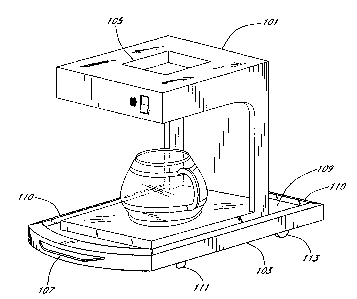Some of the information on this Web page has been provided by external sources. The Government of Canada is not responsible for the accuracy, reliability or currency of the information supplied by external sources. Users wishing to rely upon this information should consult directly with the source of the information. Content provided by external sources is not subject to official languages, privacy and accessibility requirements.
Any discrepancies in the text and image of the Claims and Abstract are due to differing posting times. Text of the Claims and Abstract are posted:
| (12) Patent Application: | (11) CA 2375932 |
|---|---|
| (54) English Title: | METHOD AND APPARATUS FOR RELOCATING COUNTER-TOP APPLIANCES |
| (54) French Title: | PROCEDE ET DISPOSITIF DE DEPLACEMENT D'APPAREIL DE DESSUS DE COMPTOIR |
| Status: | Deemed Abandoned and Beyond the Period of Reinstatement - Pending Response to Notice of Disregarded Communication |
| (51) International Patent Classification (IPC): |
|
|---|---|
| (72) Inventors : |
|
| (73) Owners : |
|
| (71) Applicants : |
|
| (74) Agent: | BARRIGAR INTELLECTUAL PROPERTY LAW |
| (74) Associate agent: | |
| (45) Issued: | |
| (86) PCT Filing Date: | 2000-06-15 |
| (87) Open to Public Inspection: | 2001-01-04 |
| Availability of licence: | N/A |
| Dedicated to the Public: | N/A |
| (25) Language of filing: | English |
| Patent Cooperation Treaty (PCT): | Yes |
|---|---|
| (86) PCT Filing Number: | PCT/US2000/040212 |
| (87) International Publication Number: | US2000040212 |
| (85) National Entry: | 2001-12-28 |
| (30) Application Priority Data: | ||||||
|---|---|---|---|---|---|---|
|
A counter top appliance (101) is placed on a mobile base (103) to allow for
the relocation of the appliance on a counter. The base includes a set of
wheels (113) and a set of bumpers (111). The wheels are used to move the base
by lifting the bumpers off the counter surface. The bumpers are used to
maintain the basis in a stationary position.
La présente invention concerne un appareil de dessus de comptoir (101) placé sur un support mobile (103) permettant audit appareil de se déplacer sur un comptoir. Le support comprend un ensemble de roues (113) et un ensemble d'éléments de blocage (111). Les roues servent à faire se déplacer le support tout en élevant les éléments de blocage par rapport à la surface du comptoir. Les éléments de blocage servent à maintenir le support dans une position stationnaire.
Note: Claims are shown in the official language in which they were submitted.
Note: Descriptions are shown in the official language in which they were submitted.

2024-08-01:As part of the Next Generation Patents (NGP) transition, the Canadian Patents Database (CPD) now contains a more detailed Event History, which replicates the Event Log of our new back-office solution.
Please note that "Inactive:" events refers to events no longer in use in our new back-office solution.
For a clearer understanding of the status of the application/patent presented on this page, the site Disclaimer , as well as the definitions for Patent , Event History , Maintenance Fee and Payment History should be consulted.
| Description | Date |
|---|---|
| Inactive: IPC from MCD | 2006-03-12 |
| Inactive: IPC from MCD | 2006-03-12 |
| Application Not Reinstated by Deadline | 2004-06-15 |
| Time Limit for Reversal Expired | 2004-06-15 |
| Deemed Abandoned - Failure to Respond to Maintenance Fee Notice | 2003-06-16 |
| Inactive: Cover page published | 2002-06-25 |
| Inactive: Notice - National entry - No RFE | 2002-06-18 |
| Inactive: Applicant deleted | 2002-06-18 |
| Application Received - PCT | 2002-04-11 |
| National Entry Requirements Determined Compliant | 2001-12-28 |
| National Entry Requirements Determined Compliant | 2001-12-28 |
| Application Published (Open to Public Inspection) | 2001-01-04 |
| Abandonment Date | Reason | Reinstatement Date |
|---|---|---|
| 2003-06-16 |
The last payment was received on 2002-06-05
Note : If the full payment has not been received on or before the date indicated, a further fee may be required which may be one of the following
Patent fees are adjusted on the 1st of January every year. The amounts above are the current amounts if received by December 31 of the current year.
Please refer to the CIPO
Patent Fees
web page to see all current fee amounts.
| Fee Type | Anniversary Year | Due Date | Paid Date |
|---|---|---|---|
| Basic national fee - standard | 2001-12-28 | ||
| MF (application, 2nd anniv.) - standard | 02 | 2002-06-17 | 2002-06-05 |
Note: Records showing the ownership history in alphabetical order.
| Current Owners on Record |
|---|
| JOSEPH P. GOLDSTON |
| Past Owners on Record |
|---|
| None |